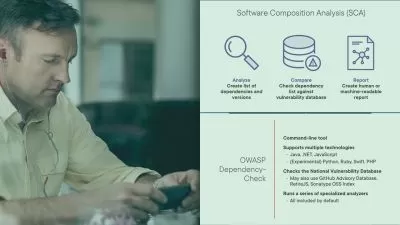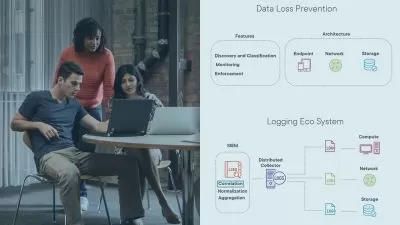Third-Party Risk Management (TPRM)
Sali̇h Ahmed Islam
1:47:57
Description
TPRM, Mitigating Vendor Risks
What You'll Learn?
- Understand the Fundamentals of Third-Party Risk Management (TPRM)
- Identify and Assess Various Types of Third-Party Risks
- Navigate the Regulatory Landscape Impacting TPRM
- Develop and Implement a Robust TPRM Framework
- Conduct Effective Third-Party Risk Assessments and Due Diligence
- Manage Third-Party Risks Through Contractual and Cybersecurity Measures
- Respond to and Mitigate Third-Party Risk Incidents
- Foster a Risk-Aware Culture and Continuous Improvement in TPRM
Who is this for?
What You Need to Know?
More details
DescriptionCourse Description-
This course provides a comprehensive guide to understanding and managing third-party risks in today’s interconnected business environment. It covers the fundamentals of third-party risk management (TPRM), including identifying, assessing, and mitigating risks associated with vendors, suppliers, and other external partners. Learn how to develop a robust TPRM framework, conduct due diligence, and monitor third-party performance to protect your organization from potential threats.
Downloadable Templates-
Lecture 6 - eBook - Due Diligence Questionnaire
Lecture 7 - eBook - Third-Party Risk Assessment Checklist
Lecture 12 - eBook - Incident Response Plan Template
Course Structure
Module 1- Introduction
Lecture 1 - Introduction
Module 2 Introduction to Third-Party Risk Management
Lecture 2- Overview of Third-Party Risk Management
Definition of third-party risk management (TPRM)
Importance of TPRM in the modern business landscape
Key components of an effective TPRM program
Lecture 3- Types of Third-Party Risks
Operational risks
Financial risks
Compliance and legal risks
Cybersecurity and data privacy risks
Reputational risks
Lecture 4- The Regulatory Landscape
Overview of global regulations impacting TPRM (GDPR, CCPA, SOX, etc.)
The role of regulatory bodies in third-party oversight
Consequences of non-compliance
Module 3- Building a Third-Party Risk Management Framework
Lecture 5- Developing a TPRM Framework
Key elements of a TPRM framework
Aligning TPRM with organizational objectives and risk appetite
Roles and responsibilities in TPRM
Lecture 6- Third-Party Risk Assessment and Due Diligence
Identifying and categorizing third-party risks
Conducting initial due diligence and background checks
Tools and techniques for risk assessment
Lecture 7- Risk Scoring and Segmentation
Creating a risk scoring model
Segmentation of third parties based on risk profiles
Prioritizing third-party risk management efforts
Module 4- Implementing Third-Party Risk Management Practices
Lecture 8- Contractual Risk Management
Key contractual clauses for managing third-party risks
Service Level Agreements (SLAs) and performance metrics
Negotiating risk-sharing and liability provisions
Lecture 9- Monitoring and Auditing Third Parties
Continuous monitoring of third-party performance
Conducting third-party audits and assessments
Using technology and tools for third-party monitoring
Lecture 10- Managing Cybersecurity and Data Privacy Risks
Understanding cybersecurity threats from third parties
Data privacy considerations and compliance
Best practices for securing third-party data
Module 5- Mitigating and Responding to Third-Party Risks
Lecture 11- Risk Mitigation Strategies
Developing risk mitigation plans
Implementing controls and safeguards
Case studies of successful risk mitigation
Lecture 12- Incident Response and Crisis Management
Preparing for third-party risk incidents
Building an incident response plan
Managing communication and damage control
Lecture 13- Terminating Third-Party Relationships
Identifying when to terminate a third-party relationship
Legal and contractual considerations
Steps for a smooth transition and offboarding
Module 6- Enhancing Third-Party Risk Management Practices
Lecture 14- Continuous Improvement in TPRM
Evaluating the effectiveness of your TPRM program
Leveraging feedback for continuous improvement
Staying updated with evolving risks and regulations
Lecture 15- The Role of Technology in TPRM
Overview of TPRM software and tools
Using data analytics to enhance TPRM
Future trends in TPRM technology
Lecture 16- Building a Risk-Aware Culture
Promoting risk awareness across the organization
Training and educating employees on TPRM
Engaging stakeholders in risk management
Who this course is for:
- Risk Management Professionals
- Compliance Officers and Auditors
- Procurement and Vendor Management Professionals
- Business Leaders and Managers
- Legal and Contract Management Professionals
- Anyone Interested in Risk Management
Course Description-
This course provides a comprehensive guide to understanding and managing third-party risks in today’s interconnected business environment. It covers the fundamentals of third-party risk management (TPRM), including identifying, assessing, and mitigating risks associated with vendors, suppliers, and other external partners. Learn how to develop a robust TPRM framework, conduct due diligence, and monitor third-party performance to protect your organization from potential threats.
Downloadable Templates-
Lecture 6 - eBook - Due Diligence Questionnaire
Lecture 7 - eBook - Third-Party Risk Assessment Checklist
Lecture 12 - eBook - Incident Response Plan Template
Course Structure
Module 1- Introduction
Lecture 1 - Introduction
Module 2 Introduction to Third-Party Risk Management
Lecture 2- Overview of Third-Party Risk Management
Definition of third-party risk management (TPRM)
Importance of TPRM in the modern business landscape
Key components of an effective TPRM program
Lecture 3- Types of Third-Party Risks
Operational risks
Financial risks
Compliance and legal risks
Cybersecurity and data privacy risks
Reputational risks
Lecture 4- The Regulatory Landscape
Overview of global regulations impacting TPRM (GDPR, CCPA, SOX, etc.)
The role of regulatory bodies in third-party oversight
Consequences of non-compliance
Module 3- Building a Third-Party Risk Management Framework
Lecture 5- Developing a TPRM Framework
Key elements of a TPRM framework
Aligning TPRM with organizational objectives and risk appetite
Roles and responsibilities in TPRM
Lecture 6- Third-Party Risk Assessment and Due Diligence
Identifying and categorizing third-party risks
Conducting initial due diligence and background checks
Tools and techniques for risk assessment
Lecture 7- Risk Scoring and Segmentation
Creating a risk scoring model
Segmentation of third parties based on risk profiles
Prioritizing third-party risk management efforts
Module 4- Implementing Third-Party Risk Management Practices
Lecture 8- Contractual Risk Management
Key contractual clauses for managing third-party risks
Service Level Agreements (SLAs) and performance metrics
Negotiating risk-sharing and liability provisions
Lecture 9- Monitoring and Auditing Third Parties
Continuous monitoring of third-party performance
Conducting third-party audits and assessments
Using technology and tools for third-party monitoring
Lecture 10- Managing Cybersecurity and Data Privacy Risks
Understanding cybersecurity threats from third parties
Data privacy considerations and compliance
Best practices for securing third-party data
Module 5- Mitigating and Responding to Third-Party Risks
Lecture 11- Risk Mitigation Strategies
Developing risk mitigation plans
Implementing controls and safeguards
Case studies of successful risk mitigation
Lecture 12- Incident Response and Crisis Management
Preparing for third-party risk incidents
Building an incident response plan
Managing communication and damage control
Lecture 13- Terminating Third-Party Relationships
Identifying when to terminate a third-party relationship
Legal and contractual considerations
Steps for a smooth transition and offboarding
Module 6- Enhancing Third-Party Risk Management Practices
Lecture 14- Continuous Improvement in TPRM
Evaluating the effectiveness of your TPRM program
Leveraging feedback for continuous improvement
Staying updated with evolving risks and regulations
Lecture 15- The Role of Technology in TPRM
Overview of TPRM software and tools
Using data analytics to enhance TPRM
Future trends in TPRM technology
Lecture 16- Building a Risk-Aware Culture
Promoting risk awareness across the organization
Training and educating employees on TPRM
Engaging stakeholders in risk management
Who this course is for:
- Risk Management Professionals
- Compliance Officers and Auditors
- Procurement and Vendor Management Professionals
- Business Leaders and Managers
- Legal and Contract Management Professionals
- Anyone Interested in Risk Management
User Reviews
Rating
Sali̇h Ahmed Islam
Instructor's Courses
Udemy
View courses Udemy- language english
- Training sessions 16
- duration 1:47:57
- Release Date 2025/01/16











